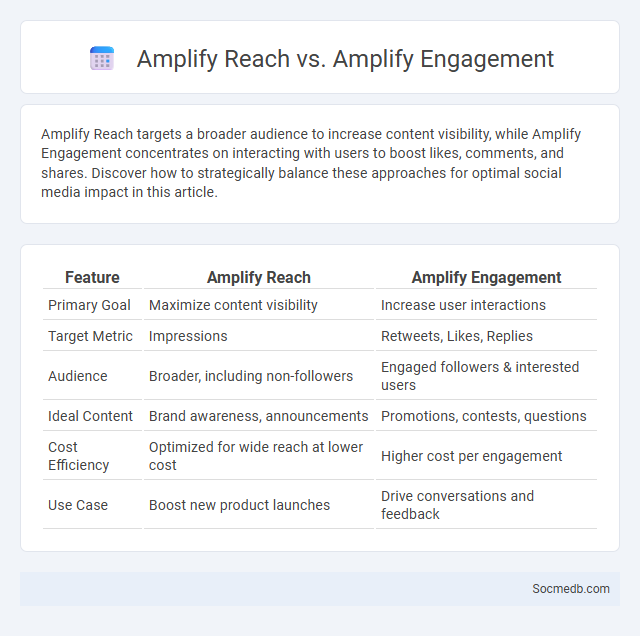
Photo illustration: Amplify Reach vs Amplify Engagement
Amplify Reach targets a broader audience to increase content visibility, while Amplify Engagement concentrates on interacting with users to boost likes, comments, and shares. Discover how to strategically balance these approaches for optimal social media impact in this article.
Table of Comparison
| Feature | Amplify Reach | Amplify Engagement |
|---|---|---|
| Primary Goal | Maximize content visibility | Increase user interactions |
| Target Metric | Impressions | Retweets, Likes, Replies |
| Audience | Broader, including non-followers | Engaged followers & interested users |
| Ideal Content | Brand awareness, announcements | Promotions, contests, questions |
| Cost Efficiency | Optimized for wide reach at lower cost | Higher cost per engagement |
| Use Case | Boost new product launches | Drive conversations and feedback |
Understanding Amplify Reach: What Does It Mean?
Amplify reach on social media means increasing the number of people who see and engage with your content through shares, comments, and likes. Your content's visibility expands as users interact and share it within their networks, boosting organic exposure. Understanding this concept helps you create strategies that maximize audience engagement and widen your social influence.
Exploring Amplify Engagement: Core Concepts
Amplifying engagement on social media platforms hinges on understanding core concepts such as audience targeting, content relevance, and interaction timing. Leveraging data analytics tools helps identify optimal posting schedules and content formats that resonate with specific demographics. Consistent use of interactive features like polls, stories, and live videos significantly boosts user participation and brand visibility.
Defining Amplification in Digital Marketing
Amplification in digital marketing refers to the strategic process of expanding the reach and engagement of content across social media platforms, ensuring it reaches a broader and more targeted audience. By leveraging influencers, paid promotions, and organic sharing, brands enhance visibility and drive more impactful interactions. Your efforts in amplification can significantly boost brand awareness and lead to increased conversions.
Key Differences: Reach vs Engagement vs Amplification
Reach measures the total number of unique users exposed to your social media content, whereas engagement quantifies the interactions such as likes, comments, and shares that show audience involvement. Amplification reflects the rate at which your content is shared or spread by users, extending its visibility beyond the original audience. Understanding these metrics enables you to tailor strategies that maximize visibility, foster interaction, and encourage content sharing effectively.
When to Prioritize Amplify Reach
Prioritize amplifying reach on social media during product launches, major announcements, or time-sensitive promotions to maximize audience exposure. Leveraging peak engagement times and trending hashtags further boosts visibility and interaction rates. Brands aiming to grow follower base or drive viral campaigns benefit most from amplifying reach strategies.
Strategies to Maximize Amplify Engagement
Implement targeted content strategies by analyzing your audience's preferences and posting during peak activity times to maximize engagement. Leverage interactive features such as polls, live videos, and stories to boost user participation and dwell time on your social media profiles. Utilize data-driven insights and A/B testing to continuously refine your approach, ensuring Your content resonates and drives meaningful interactions.
The Role of Amplification in Content Distribution
Amplification in social media plays a crucial role in maximizing content distribution by leveraging shares, likes, and comments to extend reach beyond initial followers. Algorithms prioritize content with higher engagement, increasing visibility across platforms such as Facebook, Instagram, and Twitter. Influencer partnerships and user-generated content further enhance amplification by tapping into diverse audiences, driving organic growth and brand awareness.
Measuring Success: Metrics for Reach, Engagement, and Amplification
Measuring social media success involves tracking specific metrics such as reach, engagement, and amplification to evaluate campaign effectiveness. Reach quantifies the total number of unique users exposed to content, while engagement measures interactions like likes, comments, shares, and clicks, indicating audience involvement. Amplification rate assesses how often the content is shared, expanding its visibility and potential impact across wider networks.
Case Studies: Effective Use of Each Strategy
Case studies reveal that influencer marketing on social media can increase brand engagement by up to 30%, highlighting the power of authentic endorsements. Using targeted social media ads, companies reported a 25% boost in conversion rates by reaching precise audience segments with tailored messages. You can maximize ROI by analyzing these case studies to implement the most effective strategies for your social media campaigns.
Choosing the Right Approach for Your Brand Goals
Selecting the right social media strategy depends on identifying your brand's target audience and aligning content with their preferences to maximize engagement. Utilizing data analytics tools helps refine campaign effectiveness by tracking user interactions and adjusting tactics in real-time. You can enhance brand visibility and achieve your goals by focusing on platform-specific features that resonate best with your customers.
 socmedb.com
socmedb.com